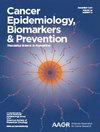红细胞多不饱和脂肪酸组成与乳腺癌死亡率:女性健康饮食与生活(WHEL)研究结果
IF 3.7
3区 医学
Q2 ONCOLOGY
引用次数: 0
摘要
目的:研究红细胞(RBC)中多不饱和脂肪酸(PUFA)成分与乳腺癌妇女死亡率之间的关系。方法:采用巢式病例对照研究:这项嵌套病例对照研究纳入了 "女性健康饮食与生活研究"(Women's Healthy Eating and Living Study)中的 1,104 名女性,该研究是一项关于改变以植物为基础的饮食习惯对乳腺癌存活率影响的随机对照试验。病例为 1995 年至 2006 年期间死于任何原因的女性(n = 290)。对照组是在随访结束时仍存活的妇女,与病例的诊断年龄、随机化后的年数、干预组和分期相匹配(n = 814)。利用气相色谱法测量了基线采集的血样中的红细胞脂肪酸组成,包括四种 n-3 和七种 n-6 PUFAS 的比例。我们使用条件逻辑回归法估算了几率比(ORs)和 95% 置信区间(CIs),研究了每种 PUFA 与全因死亡率和乳腺癌特异性死亡率的关系,并对衍生因素进行了分析。结果在完全调整模型中,PUFAs>中位数(相对于≤中位数)为α-亚麻酸(ALA,C18:3n3;OR = 1.56;95% CI = 1.14-2.14)和亚麻酸(LnA,C18:2n6,OR = 1.54;95% CI = 1.15-2.07),LnA(OR = 1.72,95% CI = 1.24-2.38)和γ-亚麻酸(GLA,C18:3n6;OR = 1.40;95% CI = 0.97-2.00)的乳腺癌特异性死亡率 ORs 升高。因子 1[花生四烯酸,C20:4n6;肾上腺酸,C22:4n6;二十二碳五烯酸,C22:5n6]得分>中位数(相对于≤中位数)与较低的全因(OR = 0.72;95% CI = 0.53-0.因子 4 [ALA 和 GLA] 评分>中位数(相对于≤中位数)与乳腺癌特异性死亡率增加的几率相关(OR = 1.42;95% CI = 1.01-2.01)。此外,因子 4 分值每增加 1 分,全因死亡率的 OR 值为 1.22(95% CI = 1.04-1.42),乳腺癌特异性死亡率的 OR 值为 1.24(95% CI = 1.05-1.47)。结论红细胞中的 PUFA 成分与乳腺癌妇女的全因死亡率和乳腺癌特异性死亡率风险有关。本文章由计算机程序翻译,如有差异,请以英文原文为准。
Red Blood Cell Polyunsaturated Fatty Acid Composition and Mortality Following Breast Cancer: Results From the Women's Healthy Eating and Living (WHEL) Study
Purpose: To examine the associations between red blood cell (RBC) composition of polyunsaturated fatty acids (PUFAs) and mortality among women with breast cancer. Methods: This nested case-control study included 1,104 women from the Women's Healthy Eating and Living Study, a randomized controlled trial of a plant-based dietary change on breast cancer survival. Cases were women who died from any cause (n = 290) from 1995 to 2006. Controls were women who were alive at the end of follow-up matched to cases on age at diagnosis, years since randomization, intervention group, and stage (n = 814). RBC fatty acid composition was measured in blood samples collected at baseline using gas chromatography and included the proportions of four n-3 and seven n-6 PUFAS. We examined each PUFA individually as well as factor analysis-derived factors in association with all-cause and breast cancer-specific mortality using conditional logistic regression to estimate odds ratios (ORs) and 95% confidence intervals (CIs). Results: In fully-adjusted models, all-cause mortality ORs were elevated among women with PUFAs >median (versus ≤ median) for alpha-linolenic acid (ALA, C18:3n3; OR = 1.56; 95% CI = 1.14–2.14) and for linolenic acid (LnA, C18:2n6, OR = 1.54; 95% CI = 1.15–2.07), and breast cancer-specific mortality ORs were elevated for LnA (OR = 1.72, 95% CI = 1.24–2.38) and gamma-linolenic acid (GLA, C18:3n6; OR = 1.40; 95% CI = 0.97–2.00). Factor 1 [arachidonic acid, C20:4n6; adrenic acid, C22:4n6; and docosapentaenoic acid, C22:5n6] scores >median (versus ≤median) were associated with lower odds of all-cause (OR = 0.72; 95% CI = 0.53–0.98) and breast cancer-specific (OR = 0.67; 95% CI = 0.47–0.94) mortality, and Factor 4 [ALA and GLA] scores >median (versus ≤median) were associated with increased odds of breast cancer-specific mortality (OR = 1.42; 95% CI = 1.01–2.01). Additionally, 1-SD increase in Factor 4 scores were associated with ORs of 1.22 (95% CI = 1.04–1.42) for all-cause mortality and 1.24 (95% CI = 1.05–1.47) for breast cancer-specific mortality. Conclusions: RBC PUFA composition profiles are associated with all-cause and breast cancer-specific mortality risk among women with breast cancer.
求助全文
通过发布文献求助,成功后即可免费获取论文全文。
去求助
来源期刊

Cancer Epidemiology Biomarkers & Prevention
医学-公共卫生、环境卫生与职业卫生
CiteScore
6.50
自引率
2.60%
发文量
538
审稿时长
1.6 months
期刊介绍:
Cancer Epidemiology, Biomarkers & Prevention publishes original peer-reviewed, population-based research on cancer etiology, prevention, surveillance, and survivorship. The following topics are of special interest: descriptive, analytical, and molecular epidemiology; biomarkers including assay development, validation, and application; chemoprevention and other types of prevention research in the context of descriptive and observational studies; the role of behavioral factors in cancer etiology and prevention; survivorship studies; risk factors; implementation science and cancer care delivery; and the science of cancer health disparities. Besides welcoming manuscripts that address individual subjects in any of the relevant disciplines, CEBP editors encourage the submission of manuscripts with a transdisciplinary approach.
 求助内容:
求助内容: 应助结果提醒方式:
应助结果提醒方式:


